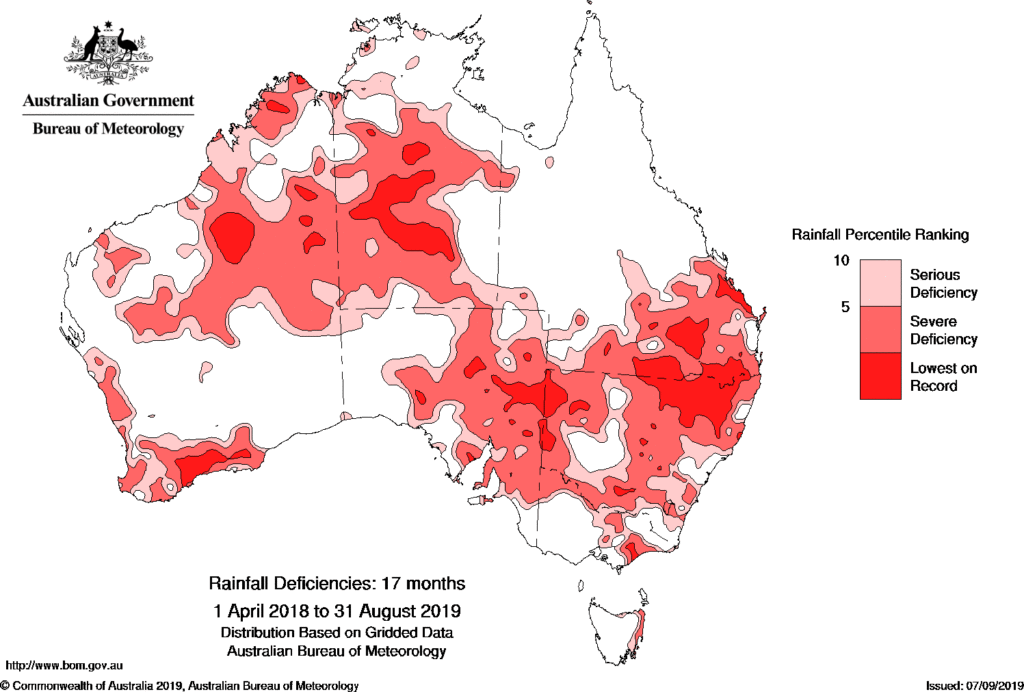By Professor Poh-Ling Tan
Griffith Law School
Friday 20 September’s rallies across the world call for climate action, but some Australians are still asking questions. Are we going through a drought or has the climate flipped to a “new normal”? Is this climate change or a climate emergency? Are climate scientists just beating things up to secure their own research funding? Messages circulating on social media report a serious drought in 1940s, so are we really experiencing the worst drought on record?
There is no doubt that Australia has recurring droughts. In eastern Australia from 1937 to 1945, there were some extremely dry years, with Black Friday bushfires in January 1939 in Victoria. Australians are very fortunate to have access to the Bureau of Meteorology’s (BoM) reports for fact checking. The BoM is government funded, non-partisan, and the public rely on their reports when it comes to weather predictions for storms or even getting on a plane. BoM’s latest drought report says
… the32 months from January 2017 to August 2019has been the driest on record averaged over the Murray—Darling Basin (34% below the 1961—1990 average), as well as over the northern Murray—Darling Basin (40% below average) and for the state of New South Wales (34% below average)… only the 1900—02 peak of the Federation Drought has been drier. The last 32 and 20 months have also been the driest on record averaged over the Border Rivers, Macquarie—Bogan, Namoi, Gwydir, and Castlereagh catchments, with the last 20 months also the driest on record for the Moonie, Condamine-Culgoa, and Lower Murray catchments.
http://www.bom.gov.au/climate/drought/

Moving away from south-eastern Australia, perhaps the most iconic feature in northern Australia is the Great Barrier Reef (GBR). Long term monitoring programs give us accurate reports of reef health. In the northern reefs, a peak level of hard coral cover or 30% was recorded in 1988. In 2019 this had declined to 14%. There is variation from year to year, and recent declines in hard coral cover followed a sequence of disturbances after 2013, including cyclones, outbreaks of crown-of-thorns starfish and mass coral bleaching. Similar findings exist for central and southern parts of the GBR. It is undeniable that the trend is downwards (https://www.aims.gov.au/reef-monitoring/gbr-condition-summary-2018-2019).
Some of our farmers, who are perhaps are more exposed to the extreme vagaries of climate than others, call for forward looking strategies to minimise climate risk. Wheat, fish, beef, diary production are all adversely affected. For example, up to 70% of wine country may be unsuitable for grapes by 2050. Instead of drought management which seeks to prop up the status quo, farmers call for cross-sectoral policies that provide systemic changes in ecosystem and natural resource management (see https://www.farmersforclimateaction.org.au).
Australia’s industries need supportive policies to be at forefront of climate ready innovation. Instead, in this respect, we are laggards while Ethiopia, Morocco, India, Chile and four other countries are top performers in meeting 2015 Paris targets. For us and our neighbours, our children and our grandkids, we need to face climate facts. Whether we accept or reject human induced climate change, we should acknowledge and act on two key messages — that we are all living with greater risk than we ever have, and it behoves us to manage the natural resources and our ecosystems more conservatively.
